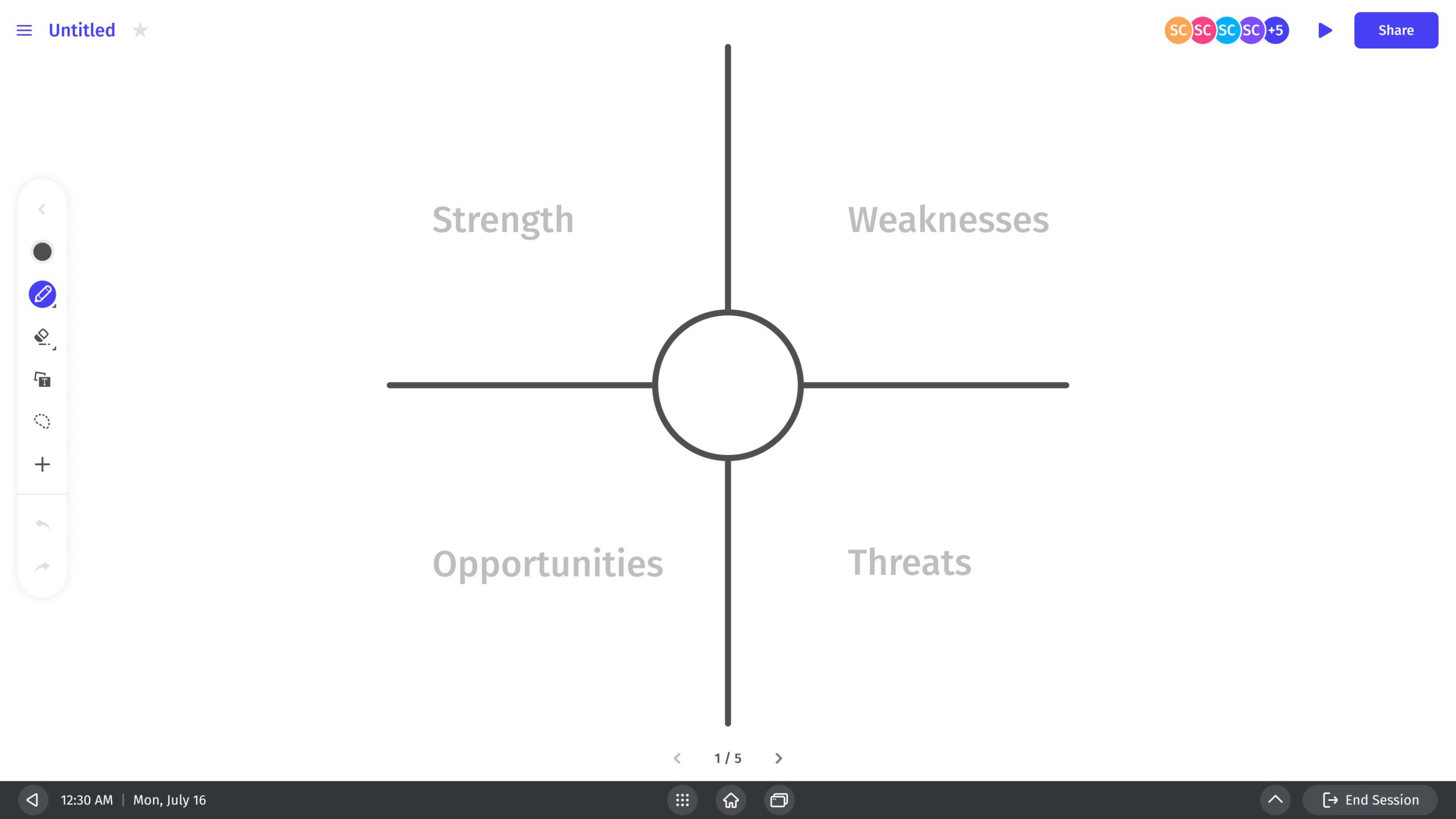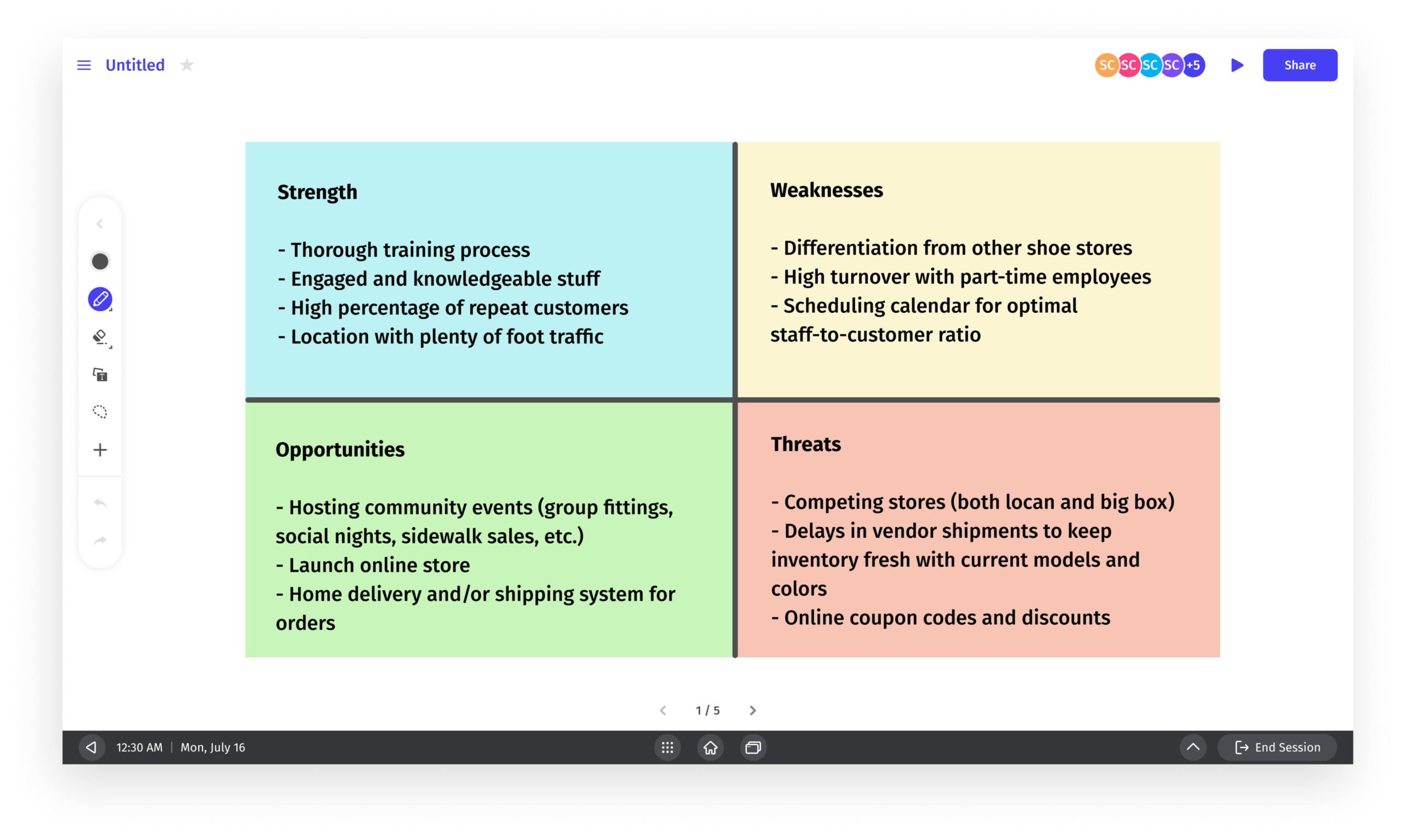On any given day, business owners have a lot to keep track of. And while they’re working to propel the business forward, it can be easy to get overwhelmed by so much information. That’s why it’s essential to create a simple strategy to focus their attention and make smart plans for the future. A S.W.O.T. analysis can help you do just that.
Conducting a proper S.W.O.T. analysis helps to inform business owners on the current state of their companies while setting goals for the coming years. We’ll cover what goes into this kind of analysis, why it makes sense for every business, and how to complete one with your team.
What is a S.W.O.T. analysis?

A S.W.O.T. analysis determines the Strengths, Weaknesses, Opportunities, and Threats of a business, a marketing campaign, a client proposal—really, a variety of business decisions can benefit from a S.W.O.T. analysis. It’s an effective way to get a handle on the current scope of the company and make more strategic plans.
Strengths are what your company does well or is known for in a positive way. Weaknesses, then, are those problem areas where your company doesn’t reach its full potential. Both strengths and weaknesses are determined by internal factors, i.e. factors that are reasonably within your power to control. For instance, maybe a local restaurant receives amazing feedback about their fun seasonal dishes (strength), but customers wish their drinks were more creative and fresh (weakness).
The opportunities and threats to a company are influenced by external factors. Opportunities are places for growth within the business, where your team can envision possibilities. Threats are points you’ll need to contend with. This could be a competitor opening a new storefront in your neighborhood or the rising cost of materials in your field, for example.
Each item on the list should be based on facts and actual data. Your team’s customer retention percentage might seem like a strength based on day-to-day activity, but confirming that hunch with data makes the analysis truly beneficial. Otherwise you’re potentially missing out on a chance to strengthen that part of your business.
Related: The Biggest Threat to Productivity is Work About Work. Here’s How to Fix It
When is this kind of analysis helpful?
Any business decision that affects a majority of the company would benefit from a S.W.O.T. analysis. Some scenarios to consider:
- Part of a company’s annual review
- Research for a product launch
- Developing a new marketing campaign
- Research for a company or product rebrand
- Expanding the company’s presence in a new location
A full-scale S.W.O.T. analysis isn’t necessary for every single decision you make. But it’s worth going through a quick rundown of the basic principles on a regular basis.
{{< blog/cta-2 “Learn how Vibe can strengthen your team’s remote collaboration” “https://vibe.us/lp/scenario-remote” >}}
Who should complete the S.W.O.T. analysis?
While each section’s list should be data-driven, it’s helpful to have different points of view contributing to the project. Your sales and IT teams could have totally different lists of the company’s strengths, and the marketing team might think of more opportunities than customer service does. So, depending on the size of the company, get as many people as possible to participate in the analysis.
Companies with departments made up of 10 or more people could have each team complete a S.W.O.T. analysis for both their department and for the company as a whole. A small business with less than 25 people on staff could easily invite everyone to participate. This will vary by project, too, so you’ll refine this process with every run-through.
If you’re making a decision that will directly impact customers—like opening a new store or revamping a popular product line—consider giving customers the opportunity to weigh in. You can use an email or social media survey to gather a few data points, then add them to what your team comes up with.
Related: What to Know About Synchronous and Asynchronous Communication
How to conduct a S.W.O.T. analysis
Once you’ve decided on the participants, give your team a point of focus for the analysis. It can be tempting to keep adding to the scope of the project. But maintaining a tight focus will help your team zero in on details.
Then, have each person make a list of the project’s strengths, weaknesses, opportunities, and threats. Using a collaborative smart whiteboard space makes this easy. Pull up Vibe’s S.W.O.T. analysis template and let team members fill in each quadrant during a group meeting. If people think of more points afterward, they can easily add them to the shared workspace.
Once everyone’s had their say, you’ll hopefully see a few patterns. Notice where your team agrees, where they bring up ideas you hadn’t considered, and where you all seem to diverge. Seeing everything in one space can help your team distill what’s most important and create a roadmap for the future.
Example: a local shoe store
Let’s take a look at how a small business might use a S.W.O.T. analysis. This locally owned shoe store has a well-established customer base. In general, things are going well and the company is able to cover their costs, but with the ongoing popularity of online shopping, it’s time to think of new ways to attract and retain customers.

After a team brainstorming session, the owner is able to see that his well-trained staff and good location could help to set his business apart from the competition and make hosting community events a strong possibility for attracting more customers. Launching an online store would also make the store’s inventory more widely available and could increase his sales over the competition.
Running through this kind of evaluation gives him an honest assessment of where the business stands and where he and his staff can direct their attention next. And with practice, a S.W.O.T. analysis can give your team this kind of insight, too.
Learn how you can use Vibe to get the the most out of your next S.W.O.T. analysis, brainstorming session, or group project by checking out vibe.us.
Vibe offers a collaborative solution combining an interactive digital whiteboard and innovative smart software. Increase engagement and efficiency at your brainstorming sessions, virtual training, and classroom sessions by integrating your favorite applications with video conferencing and an infinite, mess-free writing canvas. Collaborate today with Vibe.
Looking for the latest in interactive whiteboard technology? Check out Vibe today!
